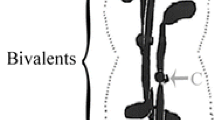Abstract
In crane fly spermatocyte meiosis 3 autosome half-bivalents normally move to each spindle pole in anaphase while the 2 amphitelic sex-chromosome univalents remain at the equator. The sex-chromosome univalents move to opposite poles after the autosomes reach the poles. — We used micromanipulation to detach half-bivalents in anaphase. When re-attached half-bivalents were syntelically oriented to the original pole, sex-chromosome segregation was usually not altered. When re-attached half-bivalents were amphitelically oriented, sex-chromosome segregation was usually altered: usually the amphitelic autosome segregated against one sex-chromosome while the other sex-chromosome remained at the equator. When re-attached half-bivalents were syntelically oriented to the opposite pole, sex-chromosome segregation was often altered: often one sex-chromosome moved normally to the spindle pole with 2 autosomal half-bivalents, while the other sex-chromosome did not move to the spindle pole with 4 autosomal half-bivalents, but remained at the equator. — The direction of motion of a sex-chromosome could be altered even after sex-chromosome segregation had begun, by suitable micromanipulation of the other sex-chromosome. — Amphitelic chromosomes that were not on the equator at the start of anaphase segregated predominantly to the closer spindle pole. Detached half-bivalents showed no preference for the closer pole when they re-attached with syntelic orientation. — We discuss some possible hypotheses for non-independent movements, and some implications of the results.
Similar content being viewed by others
References
Bauer, H., Dietz, R., Röbbelen, C.: Die Spermatocytenteilungen der Tipuliden. III. Das Bewegungsverhalten der Chromosomen in Translokationsheterozygoten von Tipula oleracea. Chromosoma (Berl.) 12, 116–189 (1961).
Behnke, O., Forer, A.: Some aspects of miorotubules in spermatocyte meiosis in a crane fly (Nephrotoma suturalis Loew): intranuclear and intrachromosomal microtubules. C.R. Lab. Carlsberg 35, 437–455 (1966).
Camenzind, R., Nicklas, R. B.: The non-random chromosome segregation in spermatocytes of Gryllotalpa hexadactyla. A micromanipulation analysis. Chromosoma (Berl.) 24, 324–335 (1968).
Dietz, R.: Centrosomenfreie Spindelpole in Tipuliden-Spermatocyten. Z. Naturforsch. 14b, 749–752 (1959).
Dietz, R.: Polarisationsmikroskopische Befunde zur chromosomeninduzierten Spindelbildung bei der Tipulide Pales crocata (Nematocera). Zool. Anz. 26, Suppl., 131–138 (1963).
Dietz, R.: Bau und Funktion des Spindelapparats. Naturwissenschaften 56, 237–248 (1969).
Forer, A.: Evidence for two spindle fiber components: a study of chromosome movement in living crane fly (Nephrotoma suturalis) spermatocytes, using polarization microscopy and an ultraviolet microbeam. Ph.D. thesis, Dartmouth College, New Hampshire (U.S.A.) (1964).
Forer, A.: Local reduction of spindle fiber birefringence in living Nephrotoma suturalis (Loew) spermatocytes induced by ultraviolet microbeam irradiation. J. Cell Biol. 25 (No. 1, Pt. 2), 95–117 (1965).
Forer, A.: Characterization of the mitotic traction system, and evidence that birefringent spindle fibers neither produce nor transmit force for chromosome movement. Chromosoma (Berl.) 19, 44–98 (1966).
Forer, A.: Chromosome movements during cell-division. In: Handbook of molecular cytology (A. Lima-de-Faria, ed.), p. 553–601. Amsterdam and London: North-Holland Publishing Company 1969.
Hughes-Schrader, S.: Distance segregation and compound sex chromosomes in mantispids (Neuroptera: Mantispidae). Chromosoma (Berl.) 27, 109–129 (1969).
Luykx, P.: Cellular mechanisms of chromosome distribution. New York and London: Academic Press 1970.
Mazia, D.: Mitosis and the physiology of cell division. In: The cell, vol. 3 (ed. J. Brachet & A. E. Mirsky), p. 77–412. New York and London: Academic Press 1961.
McIntosh, J. R., Hepler, P. K., Van Wie D. G.: Model for mitosis. Nature (Lond.) 224, 659–663 (1969).
Nakanishi, Y. H., Kato, H.: Unusual movement of the daughter chromosome group in telophasic cells following the exposure to ultraviolet microbeam irradiation. Cytologia (Tokyo) 30, 213–221 (1965).
Nicklas, R. B.: A quantitative study of chromosomal elasticity and its influence on chromosome movement. Chromosoma (Berl.) 14, 276–295 (1963).
Nicklas, R. B.: Chromosome micromanipulation. II. Induced reorientation and the experimental control of segregation in meiosis. Chromosoma (Berl.) 21, 17–50 (1967).
Nicklas, R. B.: Mitosis. Advanc. Cell Biol. 2, 225–297 (1972).
Nicklas, R. B., Koch, C.: Chromosome micromanipulation. III. Spindle fiber tension and the reorientation of mal-oriented chromosomes. J. Cell Biol. 43, 40–50 (1969).
Nicklas, R. B., Staehly, C. A.: Chromosome micromanipulation. I. The mechanics of chromosome attachment to the spindle. Chromosoma (Berl.) 21, 1–16 (1967).
Payne, F.: The chromosomes of Gryllotalpa borealis. Arch. Zellforsch. 9, 141–148 (1912).
Payne, F.: A study of the germ cells of Gryllotalpa borealis and Gryllotalpa vulgaris. J. Morph. 28, 287–327 (1916).
Author information
Authors and Affiliations
Rights and permissions
About this article
Cite this article
Forer, A., Koch, C. Influence of autosome movements and of sex-chromosome movements on sex-chromosome segregation in crane fly spermatocytes. Chromosoma 40, 417–442 (1973). https://doi.org/10.1007/BF00399432
Received:
Issue Date:
DOI: https://doi.org/10.1007/BF00399432




